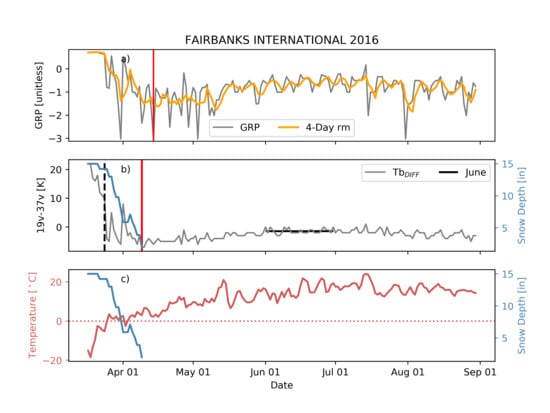A Long-Term Passive Microwave Snowoff Record for the Alaska Region 1988–2016
Abstract
1. Introduction
2. Study Area and Materials
2.1. Passive Microwave Record 1988–2016
2.2. Deriving SO
2.3. Gridded SO Datasets
2.3.1. Alaskan Snow Metrics from MODIS
2.3.2. Alaskan Snow Persistence
2.3.3. IMS
2.4. Ancillary Datasets
2.5. Assessing the Performance of the PMW SO Algorithm
2.5.1. SNOTEL Validation
2.5.2. Residuals and Uncertainty
2.6. SO Trend Analysis
3. Results
3.1. SNOTEL Site Validation
3.2. Residuals Distributed across Alaska
3.3. Assigning Uncertainty
3.4. PMW SO Trends and Anomalies
4. Discussion
5. Summary and Conclusions
Supplementary Materials
Author Contributions
Funding
Acknowledgments
Conflicts of Interest
Appendix A
| Station | Elevation [m] | Latitude [dd] | Longitude [dd] |
|---|---|---|---|
| Alexander Lake | 160 | 61.75 | −150.89 |
| Atigun Pass | 4800 | 68.13 | −149.48 |
| Chisana | 3320 | 62.07 | −142.05 |
| Coldfoot | 1040 | 67.25 | −150.18 |
| Cooper Lake | 1200 | 60.39 | −149.69 |
| Eagle Summit | 3650 | 65.49 | −145.41 |
| Fairbanks F.O. | 450 | 64.85 | −147.8 |
| Fort Yukon | 430 | 66.57 | −145.25 |
| Gobblers Knob | 2030 | 66.75 | −150.67 |
| Granite Crk | 1240 | 63.94 | −145.4 |
| Imnaviat Creek | 3050 | 68.62 | −149.3 |
| Independence Mine | 3550 | 61.79 | −149.28 |
| Kantishna | 1550 | 63.54 | −150.99 |
| Kelly Station | 310 | 67.93 | −162.28 |
| Little Chena Ridge | 2000 | 65.12 | −146.73 |
| May Creek | 1610 | 61.35 | −142.71 |
| Monahan Flat | 2710 | 63.31 | −147.65 |
| Monument Creek | 1850 | 65.08 | −145.87 |
| Mt. Ryan | 2800 | 65.25 | −146.15 |
| Munson Ridge | 3100 | 64.85 | −146.21 |
| Pargon Creek | 100 | 64.99 | −163.1 |
| Rhoads Creek | 1225 | 63.93 | −145.33 |
| Sagwon | 1000 | 69.42 | −148.69 |
| Summit Creek | 1400 | 60.62 | −149.53 |
| Susitna Valley High | 375 | 62.13 | −150.04 |
| Telaquana Lake | 1275 | 60.98 | −153.92 |
| Teuchet Creek | 1640 | 64.95 | −145.52 |
| Tokositna Valley | 850 | 62.63 | −150.78 |
| Upper Chena | 2850 | 65.1 | −144.93 |
| Upper Nome Creek | 2520 | 65.37 | −146.59 |
| Upper Tsaina River | 1750 | 61.19 | −145.65 |
| Source | Landcover | MAE [days] | |
|---|---|---|---|
| <14 | >14 | ||
| PMW | FW [%] | 0.88 | 5.33 |
| PMW | FF [%] | 17.38 | 17.83 |
| PMW | TC [m] | 113.81 | 64.50 |
| IMS | FW [%] | 2.06 | 2.25 |
| IMS | FF [%] | 20.06 | 6.00 |
| IMS | TC [m] | 103.56 | 86.00 |
| Landsat | FW [%] | 1.60 | 3.14 |
| Landsat | FF [%] | 19.07 | 14.14 |
| Landsat | TC [m] | 116.80 | 65.14 |
| MODIS | FW [%] | 0.64 | 3.55 |
| MODIS | FF [%] | 13.55 | 21.45 |
| MODIS | TC [m] | 104.18 | 96.55 |
| Year | Slope Coefficients | ||
|---|---|---|---|
| PMW/IMS | PMW/Landsat | PMW/MODIS | |
| 2004 | 0.36 | 0.47 | 0.54 |
| 2005 | 0.31 | 0.40 | 0.34 |
| 2006 | 0.35 | 0.35 | 0.47 |
| 2007 | 0.48 | 0.44 | 0.38 |
| 2008 | 0.52 | 0.37 | 0.37 |
| 2009 | 0.45 | 0.34 | 0.41 |
| 2010 | 0.49 | 0.42 | 0.40 |
| 2011 | 0.29 | 0.24 | 0.27 |
| 2012 | 0.45 | 0.28 | 0.34 |
| 2013 | 0.34 | 0.23 | 0.36 |
| 2014 | 0.41 | 0.31 | 0.27 |
| 2015 | 0.26 | 0.25 | 0.23 |
| 2016 | 0.40 | 0.44 | 0.36 |
| Mean | 0.39 | 0.35 | 0.37 |
References
- Derksen, C.; Brown, R. Spring snow cover extent reductions in the 2008-2012 period exceeding climate model projections. Geophys. Res. Lett. 2012, 39, 1–6. [Google Scholar] [CrossRef]
- Bhatt, U.S.; Walker, D.A.; Raynolds, M.K.; Comiso, J.C.; Epstein, H.E.; Jia, G.; Gens, R.; Pinzon, J.E.; Tucker, C.J.; Tweedie, C.E.; et al. Circumpolar Arctic tundra vegetation change is linked to sea ice decline. Earth Interact. 2010, 14, 1–20. [Google Scholar] [CrossRef]
- Chapin, F.S.; Sturm, M.; Serreze, M.C.; McFadden, J.P.; Key, J.R.; Lloyd, A.H.; McGuire, A.D.; Rupp, T.S.; Lynch, A.H.; Schimel, J.P.; et al. Role of land-surface changes in arctic summer warming. Science 2005, 310, 657–660. [Google Scholar] [CrossRef]
- Serreze, M.C.; Francis, J.A. The arctic amplification debate. Clim. Chang. 2006, 76, 241–264. [Google Scholar] [CrossRef]
- Stroeve, J.; Holland, M.M.; Meier, W.; Scambos, T.; Serreze, M. Arctic sea ice decline: Faster than forecast. Geophys. Res. Lett. 2007, 34, 1–5. [Google Scholar] [CrossRef]
- Du, J.; Kimball, J.S.; Duguay, C.; Kim, Y.; Watts, J.D. Satellite microwave assessment of Northern Hemisphere lake ice phenology from 2002 to 2015. Cryosphere 2017, 11, 47–63. [Google Scholar] [CrossRef]
- Liu, Z.; Kimball, J.S.; Parazoo, N.C.; Ballantyne, A.P.; Wang, W.J.; Madani, N.; Pan, C.G.; Watts, J.D.; Reichle, R.H.; Sonnentag, O.; et al. Increased high-latitude photosynthetic carbon gain offset by respiration carbon loss during an anomalous warm winter to spring transition. Glob. Chang. Biol. 2019. [Google Scholar] [CrossRef] [PubMed]
- Kim, Y.; Kimball, J.S.; Robinson, D.A.; Derksen, C. New satellite climate data records indicate strong coupling between recent frozen season changes and snow cover over high northern latitudes. Environ. Res. Lett. 2015, 10, 1–10. [Google Scholar] [CrossRef]
- Pulliainen, J.; Aurela, M.; Laurila, T.; Aalto, T.; Takala, M.; Salminen, M.; Kulmala, M.; Barr, A.; Heimann, M.; Lindroth, A.; et al. Early snowmelt significantly enhances boreal springtime carbon uptake. Proc. Natl. Acad. Sci. USA 2017, 114, 201707889. [Google Scholar] [CrossRef]
- Ling, F.; Zhang, T. Impact of the timing and duration of seasonal snow cover on the active layer and permafrost in the Alaskan Arctic. Permafr. Periglac. Process. 2003, 14, 141–150. [Google Scholar] [CrossRef]
- Niittynen, P.; Heikkinen, R.K.; Luoto, M. Snow cover is a neglected driver of Arctic biodiversity loss. Nat. Clim. Chang. 2018, 8, 997–1001. [Google Scholar] [CrossRef]
- Phoenix, G. Arctic plants threatened by winter snow loss. Nat. Clim. Chang. 2018, 8, 942–943. [Google Scholar] [CrossRef]
- Lindsay, C.; Zhu, J.; Miller, A.E.; Kirchner, P.; Wilson, T.L. Deriving snow cover metrics for Alaska from MODIS. Remote Sens. 2015, 7, 12961–12985. [Google Scholar] [CrossRef]
- Liston, G.E.; McFadden, J.P.; Sturm, M. Modelled changes in arctic tundra snow, energy and moisture fluxes due to increased shrubs. Glob. Chang. Biol. 2002, 8, 17–32. [Google Scholar] [CrossRef]
- Liston, G.E.; Hiemstra, C.A. The Changing Cryosphere: Pan-Arctic Snow Trends (1979–2009). J. Clim. 2011, 24, 5691–5712. [Google Scholar] [CrossRef]
- Bieniek, P.A.; Walsh, J.E.; Thoman, R.L.; Bhatt, U.S. Using climate divisions to analyze variations and trends in Alaska temperature and precipitation. J. Clim. 2014, 27, 2800–2818. [Google Scholar] [CrossRef]
- Boelman, N.T.; Liston, G.E.; Gurarie, E.; Meddens, A.J.H.; Mahoney, P.J.; Kirchner, P.B.; Bohrer, G.; Brinkman, T.J.; Cosgrove, C.L.; Eitel, J.U.H.; et al. Integrating snow science and wildlife ecology in Arctic-boreal North America. Environ. Res. Lett. 2019, 14, 010401. [Google Scholar] [CrossRef]
- Hall, D.K.; Riggs, G.A.; Foster, J.L.; Kumar, S.V. Development and evaluation of a cloud-gap-filled MODIS daily snow-cover product. Remote Sens. Environ. 2010, 114, 496–503. [Google Scholar] [CrossRef]
- Munkhjargal, M.; Groos, S.; Pan, C.G.; Yadamsuren, G.; Yamkin, J.; Menzel, L. Multi-Source Based Spatio-Temporal Distribution of Snow in a Semi-Arid Headwater Catchment of Northern Mongolia. Geosciences 2019, 9, 53. [Google Scholar] [CrossRef]
- Painter, T.H.; Rittger, K.; McKenzie, C.; Slaughter, P.; Davis, R.E.; Dozier, J. Retrieval of subpixel snow covered area, grain size, and albedo from MODIS. Remote Sens. Environ. 2009, 113, 868–879. [Google Scholar] [CrossRef]
- Che, T.; Dai, L.; Zheng, X.; Li, X.; Zhao, K. Estimation of snow depth from passive microwave brightness temperature data in forest regions of northeast China. Remote Sens. Environ. 2016, 183, 334–349. [Google Scholar] [CrossRef]
- Tedesco, M.; Miller, J. Observations and statistical analysis of combined active-passive microwave space-borne data and snow depth at large spatial scales. Remote Sens. Environ. 2007, 111, 382–397. [Google Scholar] [CrossRef]
- Foster, J.L.; Sun, C.; Walker, J.P.; Kelly, R.; Chang, A.; Dong, J.; Powell, H. Quantifying the uncertainty in passive microwave snow water equivalent observations. Remote Sens. Environ. 2005, 94, 187–203. [Google Scholar] [CrossRef]
- Wang, L.; Derksen, C.; Brown, R. Detection of pan-Arctic terrestrial snowmelt from QuikSCAT, 2000-2005. Remote Sens. Environ. 2008, 112, 3794–3805. [Google Scholar] [CrossRef]
- Wang, L.; Toose, P.; Brown, R.; Derksen, C. Frequency and distribution of winter melt events from passive microwave satellite data in the pan-Arctic, 1988–2013. Cryosphere 2016, 10, 2589–2602. [Google Scholar] [CrossRef]
- Pan, C.G.; Kirchner, P.; Kimball, J.S.; Kim, Y.; Du, J. Rain-on-snow events in Alaska, and their frequency and distribution from satellite observations. Environ. Res. Lett. 2018, 13. [Google Scholar] [CrossRef]
- Liu, H.; Wang, L.; Jezek, K.C. Wavelet-transform based edge detection approach to derivation of snowmelt onset, end and duration from satellite passive microwave measurements. Int. J. Remote Sens. 2005, 26, 4639–4660. [Google Scholar] [CrossRef]
- Semmens, K.A.; Ramage, J.M. Recent changes in spring snowmelt timing in the Yukon River basin detected by passive microwave satellite data. Cryosphere 2013, 7, 905–916. [Google Scholar] [CrossRef]
- Foster, J.L. The significance of the date of snow disappearance on the arctic tundra as a possible indicator of climate change. Arct. Alp. Res. 1989, 21, 60–70. [Google Scholar] [CrossRef]
- Metsämäki, S.; Böttcher, K.; Pulliainen, J.; Luojus, K.; Cohen, J.; Takala, M.; Mattila, O.-P.; Schwaizer, G.; Derksen, C.; Koponen, S. The accuracy of snow melt-off day derived from optical and microwave radiometer data—A study for Europe. Remote Sens. Environ. 2018, 211, 1–12. [Google Scholar] [CrossRef]
- Macander, M.J.; Swingley, C.S.; Joly, K.; Raynolds, M.K. Landsat-based snow persistence map for northwest Alaska. Remote Sens. Environ. 2015, 163, 23–31. [Google Scholar] [CrossRef]
- Salomonson, V.V.; Appel, I. Development of the aqua MODIS NDSI fractional snow cover algorithm and validation results. IEEE Trans. Geosci. Remote Sens. 2006, 44, 1747–1756. [Google Scholar] [CrossRef]
- Rittger, K.; Painter, T.H.; Dozier, J. Assessment of methods for mapping snow cover from MODIS. Adv. Water Resour. 2013, 51, 367–380. [Google Scholar] [CrossRef]
- Rees, A.; Lemmetyinen, J.; Derksen, C.; Pulliainen, J.; English, M. Remote Sensing of Environment Observed and modelled effects of ice lens formation on passive microwave brightness temperatures over snow covered tundra. Remote Sens. Environ. 2010, 114, 116–126. [Google Scholar] [CrossRef]
- Kim, Y.; Kimball, J.S.; Glassy, J.; Du, J. An extended global Earth system data record on daily landscape freeze – thaw status determined from satellite passive microwave remote sensing. Earch Syst. Sci. Data 2017, 9, 133–147. [Google Scholar] [CrossRef]
- Kim, Y.; Kimball, J.S.; Zhang, K.; McDonald, K.C. Satellite detection of increasing Northern Hemisphere non-frozen seasons from 1979 to 2008: Implications for regional vegetation growth. Remote Sens. Environ. 2012, 121, 472–487. [Google Scholar] [CrossRef]
- Ramage, J.M.; Isacks, B.L. Determination of melt-onset and refreeze timing on southeast Alaskan icefields using SSM/I diurnal amplitude variations. Ann. Glaciol. 2002, 34, 391–398. [Google Scholar] [CrossRef]
- Tedesco, M. Snowmelt detection over the Greenland ice sheet from SSM/I brightness temperature daily variations. Geophys. Res. Lett. 2007, 34, 1–6. [Google Scholar] [CrossRef]
- Takala, M.; Pulliainen, J.; Metsamaki, S.J.; Koskinen, J.T. Detection of snowmelt using spaceborne microwave radiometer data in Eurasia from 1979 to 2007. IEEE Trans. Geosci. Remote Sens. 2009, 47, 2996–3007. [Google Scholar] [CrossRef]
- O’Neel, S.; Hood, E.; Bidlack, A.L.; Fleming, S.W.; Arimitsu, M.L.; Arendt, A.; Burgess, E.; Sergeant, C.J.; Beaudreau, A.H.; Timm, K.; et al. Icefield-to-ocean linkages across the northern pacific coastal temperate rainforest ecosystem. Bioscience 2015, 65, 499–512. [Google Scholar] [CrossRef]
- Bieniek, P.A.; Bhatt, U.S.; Thoman, R.L.; Angeloff, H.; Partain, J.; Papineau, J.; Fritsch, F.; Holloway, E.; Walsh, J.E.; Daly, C.; et al. Climate divisions for Alaska based on objective methods. J. Appl. Meteorol. Climatol. 2012, 51, 1276–1289. [Google Scholar] [CrossRef]
- Brodzik, M.J.; Long, D.G.; Hardman, M.A.; Paget, A.; Armstrong, R. MEaSUREs Calibrated Enhanced-Resolution Passive Microwave Daily EASE-Grid 2.0 Brightness Temperature ESDR, Version 1; NASA National Snow and Ice Data Center Distributed Active Archive Center: Boulder, CO, USA, 2018.
- Brodzik, M.; Long, D.; Hardman, M. Best Practices in Crafting the Calibrated, Enhanced-Resolution Passive-Microwave EASE-Grid 2.0 Brightness Temperature Earth System Data Record. Remote Sens. 2018, 10, 1793. [Google Scholar] [CrossRef]
- Abdalati, W.; Steffen, K.; Otto, C.; Jezek, K.C. Comparison of brightness temperatures from SSMI instruments on the DMSP F8 and F11 satellites for Antarctica and the Greenland ice sheet. Int. J. Remote Sens. 1995, 16, 1223–1229. [Google Scholar] [CrossRef]
- Wang, L.; Derksen, C.; Brown, R.; Markus, T. Recent changes in pan-Arctic melt onset from satellite passive microwave measurements. Geophys. Res. Lett. 2013, 40, 522–528. [Google Scholar] [CrossRef]
- Ferraro, R.R.; Kusselson, S.; Colton, M. An introduction to passive microwave remote sensing and its applidcations to meteorological analysis and forecasting. Natl. Weather Dig. 1999, 11–23. [Google Scholar]
- Chang, A.T.C.; Foster, J.L.; Hall, D.K. Nimbus- 7 smmr derived global snow cover parameters. Ann. Glaciol. 1987, 9, 39–44. [Google Scholar] [CrossRef]
- Long, D.G. Scatterometer Backscatter Imaging Using Backus–Gilbert Inversion. IEEE Trans. Geosci. Remote Sens. 2019, 57, 3179–3190. [Google Scholar] [CrossRef]
- Dolant, C.; Langlois, A.; Montpetit, B.; Brucker, L.; Roy, A.; Royer, A. Development of a rain-on-snow detection algorithm using passive microwave radiometry. Hydrol. Process. 2016, 30, 3184–3196. [Google Scholar] [CrossRef]
- Hall, D.K.; Riggs, G.A.; Salomonson, V.V.; DiGirolamo, N.E.; Bayr, K.J. MODIS snow-cover products. Remote Sens. Environ. 2002, 83, 181–194. [Google Scholar] [CrossRef]
- Helfrich, S.R.; Mcnamara, D.; Ramsay, B.H.; Baldwin, T.; Kasheta, T. Enhancements to, and forthcoming developments in the Interactive Multisensor Snow and Ice Mapping System (IMS). Hydrol. Process. 2007, 21, 1576–1586. [Google Scholar] [CrossRef]
- National Ice Center. IMS Daily Northern Hemisphere Snow and Ice Analysis at 1 km, 4 km, and 24 km Resolutions, Version 1; National Ice Center: Boulder, CO, USA, 2008.
- Cooper, M.J.; Martin, R.V.; Lyapustin, A.I.; McLinden, C.A. Assessing snow extent data sets over North America to inform and improve trace gas retrievals from solar backscatter. Atmos. Meas. Tech. 2018, 11, 2983–2994. [Google Scholar] [CrossRef] [PubMed]
- Du, J.; Kimball, J.S.; Jones, L.A.; Kim, Y.; Glassy, J.; Watts, J.D. A global satellite environmental data record derived from AMSR-E and AMSR2 microwave Earth observations. Earth Syst. Sci. Data 2017, 9, 791–808. [Google Scholar] [CrossRef]
- Kim, Y.; Kimball, J.S.; Xu, X.; Dunbar, R.S.; Colliander, A.; Derksen, C. Global assessment of the SMAP freeze/thaw data record and regional applications for detecting spring onset and frost events. Remote Sens. 2019, 11, 1317. [Google Scholar] [CrossRef]
- Du, J.; Kimball, J.S.; Jones, L.A.; Watts, J.D. Implementation of satellite based fractional water cover indices in the pan-Arctic region using AMSR-E and MODIS. Remote Sens. Environ. 2016, 184, 469–481. [Google Scholar] [CrossRef]
- Du, J.; Kimball, J.S.; Reichle, R.H.; Jones, L.A.; Watts, J.D.; Kim, Y. Global Satellite Retrievals of the Near-Surface Atmospheric Vapor Pressure Deficit from AMSR-E. Remote Sens. 2018, 10, 1175. [Google Scholar] [CrossRef] [PubMed]
- Carroll, M.; Townshend, J.; Hansen, M.; DiMiceli, C.; Sohlberg, R.; Wurster, K. MODIS Vegetative Cover Conversion and Vegetation Continuous Fields BT—Land Remote Sensing and Global Environmental Change: NASA’s Earth Observing System and the Science of ASTER and MODIS. In Remote Sensing and Digital Image Processing; Ramachandran, B., Justice, C.O., Abrams, M.J., Eds.; Springer: New York, NY, USA, 2011; pp. 725–745. ISBN 978-1-4419-6749-7. [Google Scholar]
- Sen, P.K. Estimates of the Regression Coefficient Based on Kendall’s Tau. J. Am. Stat. Assoc. 1968, 63, 1379–1389. [Google Scholar] [CrossRef]
- Kendall, M.G. Rank Correlation Methods; Griffin: Oxford, UK, 1948. [Google Scholar]
- NOAA National Centers for Environmental Information. State of the Climate: National Climate Report for Spring (MAM); NOAA National Centers for Environmental Information: Asheville, NC, USA, 2005.
- Walsh, J.E.; Bieniek, P.A.; Brettschneider, B.; Euskirchen, E.S.; Lader, R.; Thoman, R.L. The exceptionally warm winter of 2015/16 in Alaska. J. Clim. 2017, 30, 2069–2088. [Google Scholar] [CrossRef]
- Stone, R.S.; Dutton, E.G.; Harris, J.M.; Longenecker, D. Earlier spring snowmelt in northern Alaska as an indicator of climate change. J. Geophys. Res. D Atmos. 2002, 107, 10–11. [Google Scholar] [CrossRef]
- Liston, G.E.; Sturm, M. Winter precipitation patterns in arctic Alaska determined from a blowing-snow model and snow-depth observations. J. Hydrometeorol. 2002, 3, 646–659. [Google Scholar] [CrossRef]
- Brodzik, M.J.; Billingsley, B.; Haran, T.; Raup, B.; Savoie, M.H. EASE-Grid 2.0: Incremental but Significant Improvements for Earth-Gridded Data Sets. ISPRS Int. J. Geo-Inf. 2012, 1, 32–45. [Google Scholar] [CrossRef]
- Pan, C.G.; Kimball, J.S.; Munkhjargal, M.; Robinson, N.P.; Tijdeman, E.; Menzel, L.; Kirchner, P.B. Role of Surface Melt and Icing Events in Livestock Mortality across Mongolia’s Semi-Arid Landscape. Remote Sens. 2019, 11, 2392. [Google Scholar] [CrossRef]
- Woo, M.; Young, K.L. High Arctic wetlands: Their occurrence, hydrological characteristics and Sustainability. J. Hydrol. 2006, 320, 432–450. [Google Scholar] [CrossRef]
- Bartsch, A.; Trofaier, A.M.; Hayman, G.; Sabel, D.; Schlaffer, S.; Clark, D.B.; Blyth, E. Detection of open water dynamics with ENVISAT ASAR in support of land surface modelling at high latitudes. Biogeosciences 2012, 9, 703–714. [Google Scholar] [CrossRef]
- Watts, J.D.; Kimball, J.S.; Jones, L.A.; Schroeder, R.; McDonald, K.C. Satellite Microwave remote sensing of contrasting surface water inundation changes within the Arctic-Boreal Region. Remote Sens. Environ. 2012, 127, 223–236. [Google Scholar] [CrossRef]
- Prowse, T.D.; Brown, K. Appearing and disappearing lakes in the Arctic and their impacts on biodiversity. Arct. Biodivers. Trends 2010, 2010, 68–70. [Google Scholar]
- Hall, D.K.; Sturm, M.; Benson, C.S.; Chang, A.T.C.; Foster, J.L.; Garbeil, H.; Chacho, E. Passive microwave remote and in situ measurements of artic and subarctic snow covers in Alaska. Remote Sens. Environ. 1991, 38, 161–172. [Google Scholar] [CrossRef]
- Tedesco, M.; Jeyaratnam, J. A new operational snow retrieval algorithm applied to historical AMSR-E brightness temperatures. Remote Sens. 2016, 8, 1037. [Google Scholar] [CrossRef]
- Jarvis, P.; Linder, S. Constraints to growth of boreal forests. Nature 2000, 405, 904–905. [Google Scholar] [CrossRef]
- Hall, D.; Riggs, G. Accuracy assessment of the MODIS snow products. Hydrol. Process. 2007, 21, 1534–1547. [Google Scholar] [CrossRef]
- Colby, J.D. Topographic Normalization in Rugged Terrain. Photogramm. Eng. Remote Sens. 1991, 57, 531–537. [Google Scholar]
- Hammond, J.C.; Saavedra, F.A.; Kampf, S.K. Global snow zone maps and trends in snow persistence 2001-2016. Int. J. Climatol. 2018, 38, 4369–4383. [Google Scholar] [CrossRef]
- Kunkel, K.E.; Robinson, D.A.; Champion, S.; Yin, X.; Estilow, T.; Frankson, R.M. Trends and Extremes in Northern Hemisphere Snow Characteristics. Curr. Clim. Chang. Rep. 2016, 2, 65–73. [Google Scholar] [CrossRef]
- Cohen, J.; Screen, J.A.; Furtado, J.C.; Barlow, M.; Whittleston, D.; Coumou, D.; Francis, J.; Dethloff, K.; Entekhabi, D.; Overland, J.; et al. Recent Arctic amplification and extreme mid-latitude weather. Nat. Geosci. 2014, 7, 627–637. [Google Scholar] [CrossRef]
- Watanabe, M.; Shiogama, H.; Tatebe, H.; Hayashi, M.; Ishii, M.; Kimoto, M. Contribution of natural decadal variability to global warming acceleration and hiatus. Nat. Clim. Chang. 2014, 4, 893–897. [Google Scholar] [CrossRef]
- Trenberth, K.E.; Fasullo, J.T. An apparent hiatus in global warming? Earth’s Future 2013, 1, 19–32. [Google Scholar] [CrossRef]
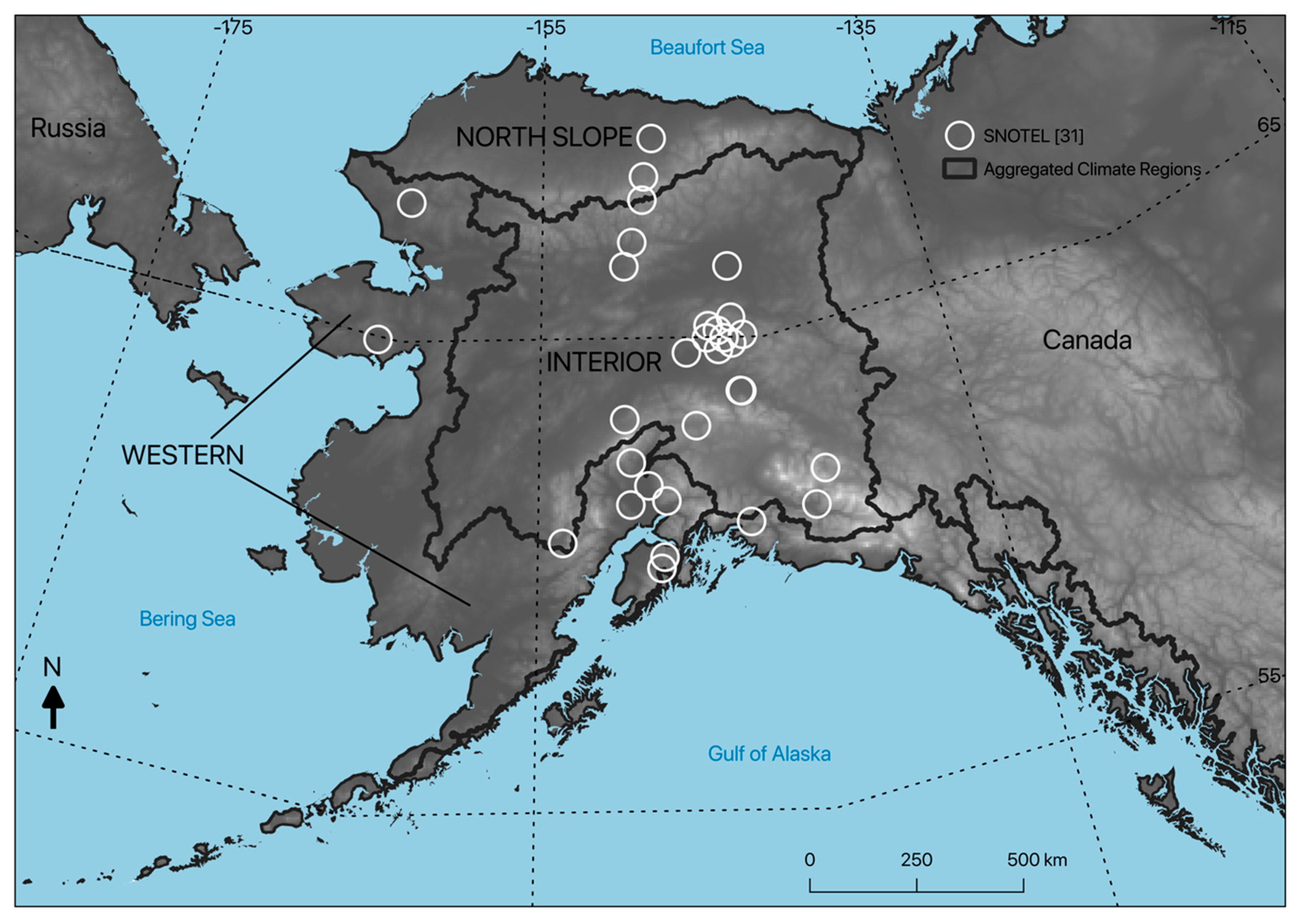
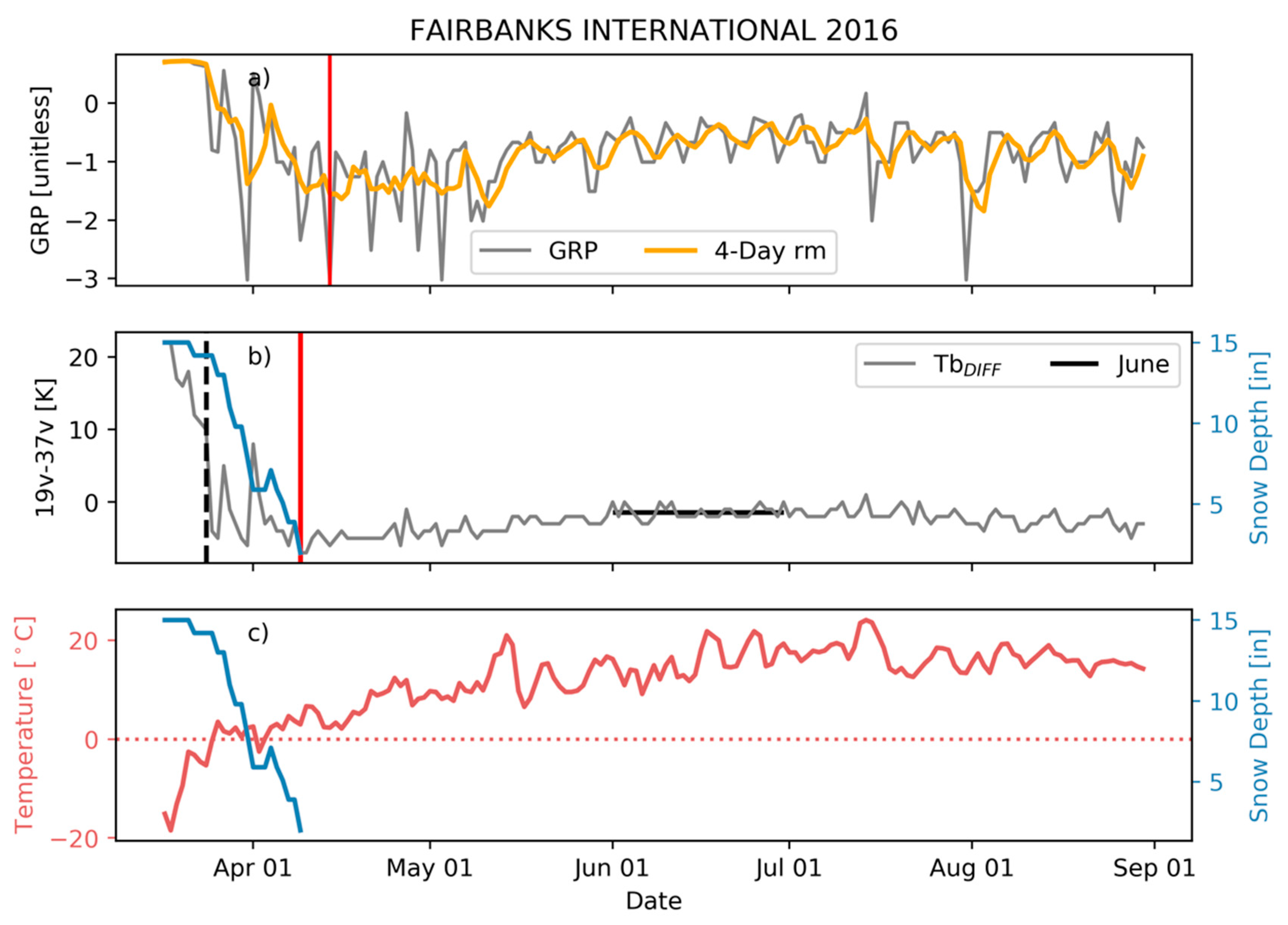
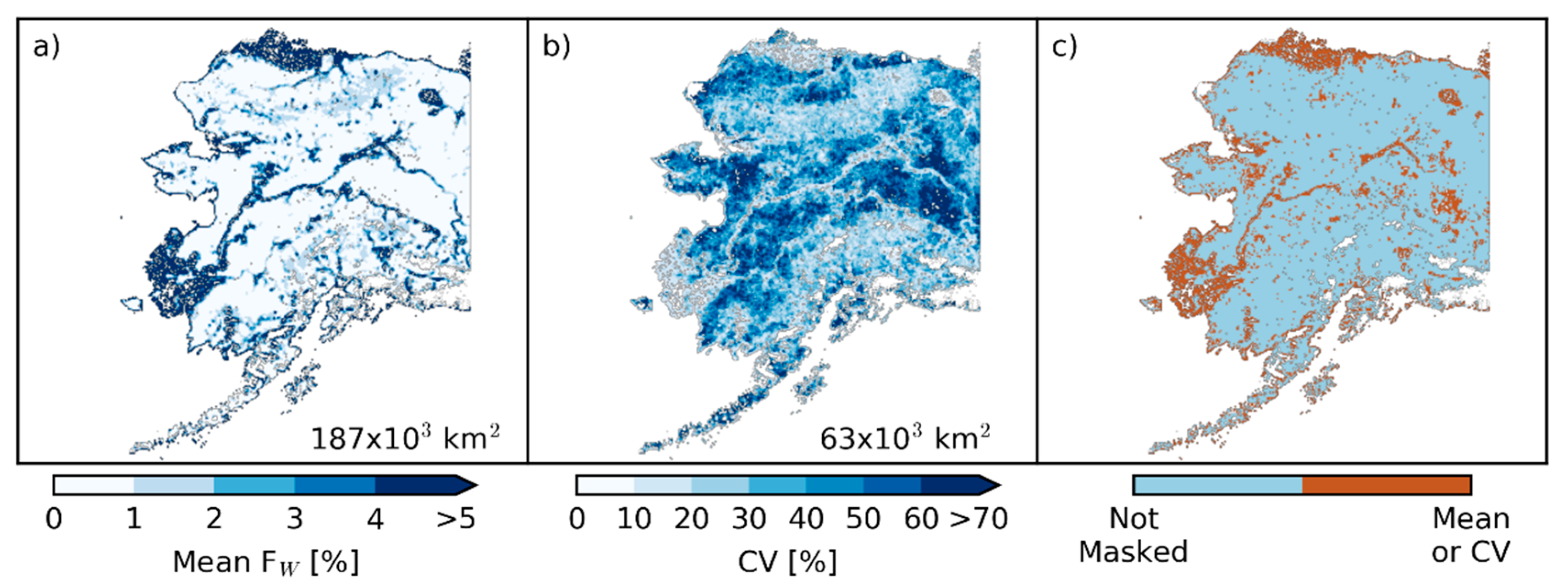
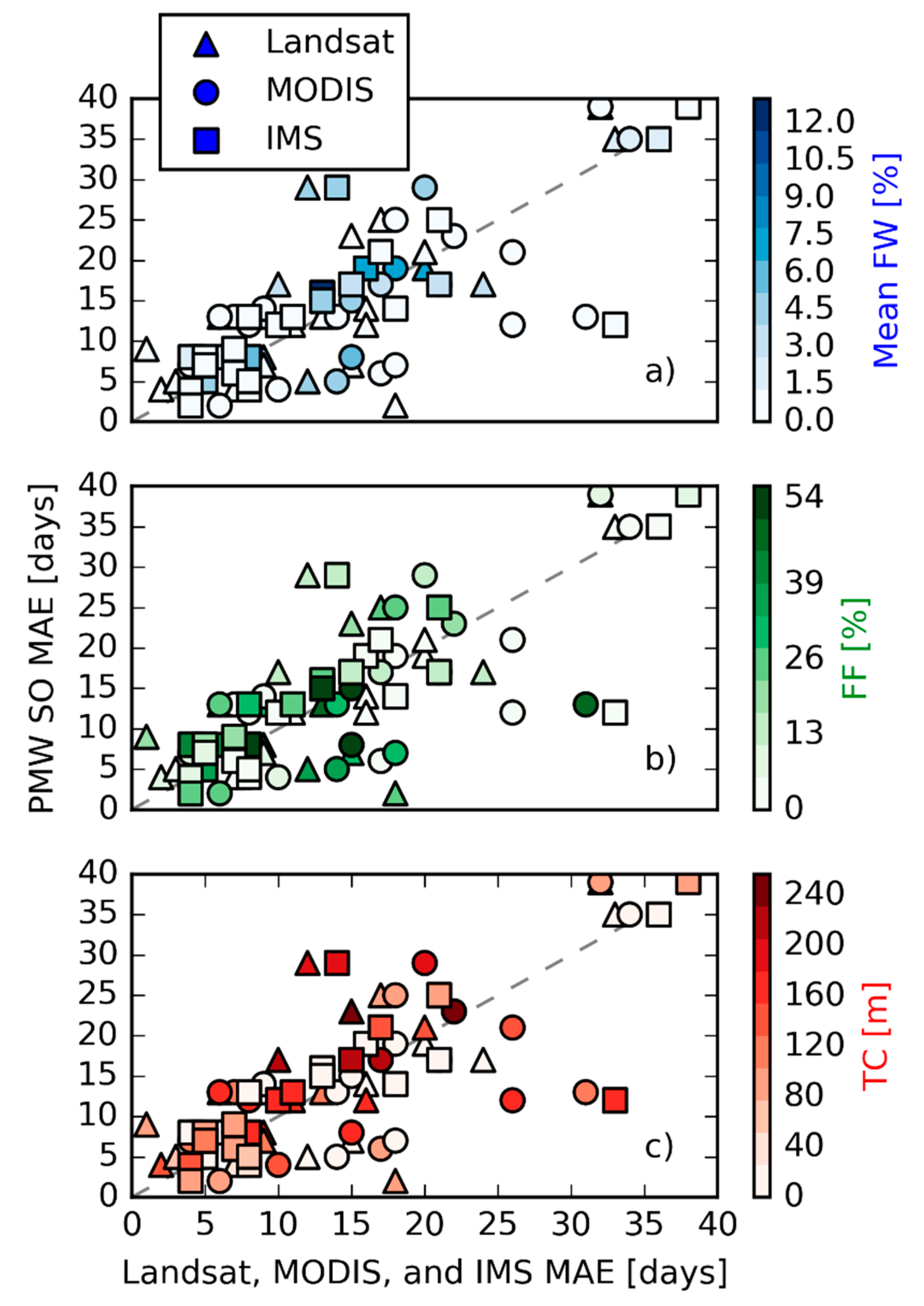
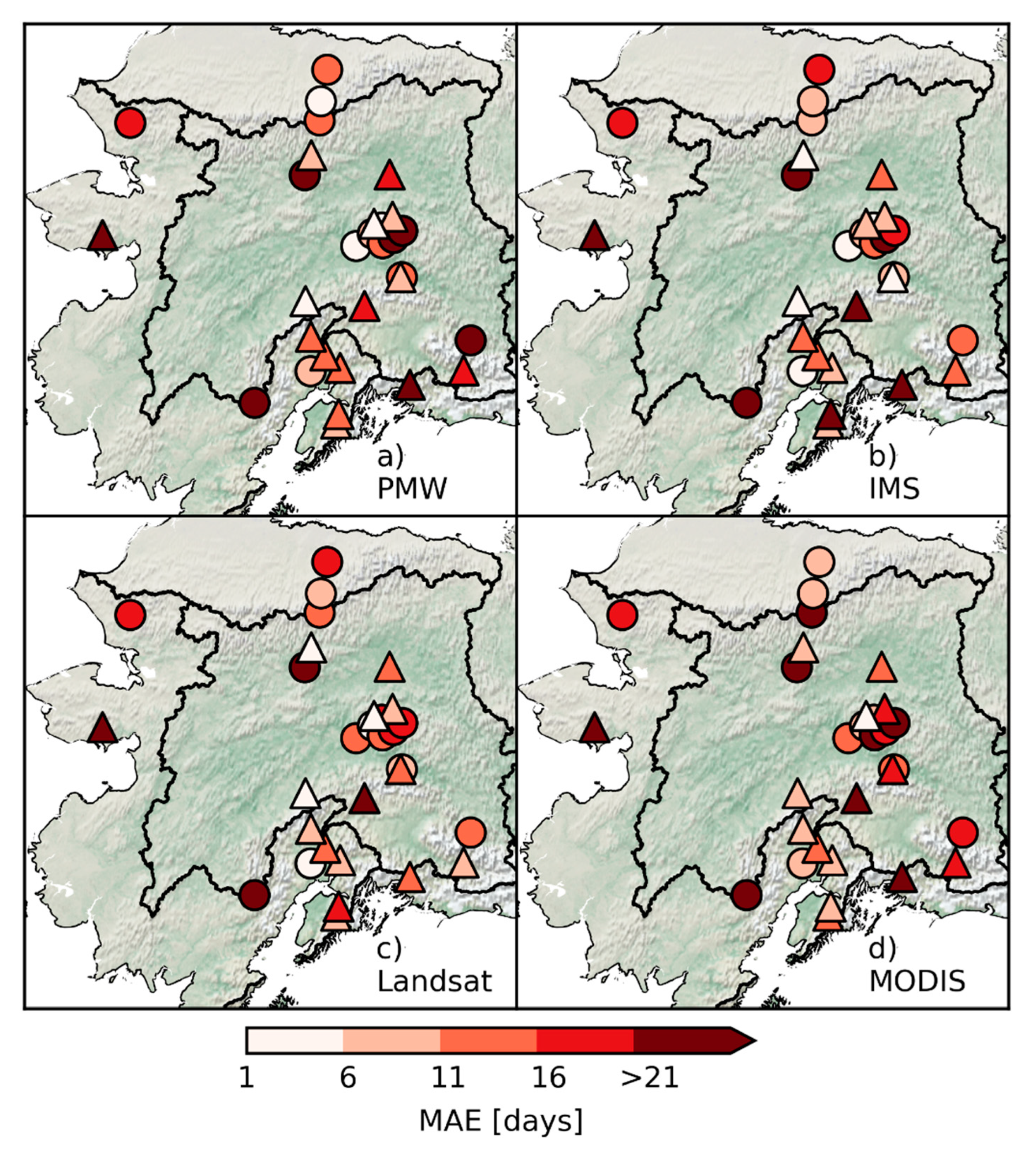
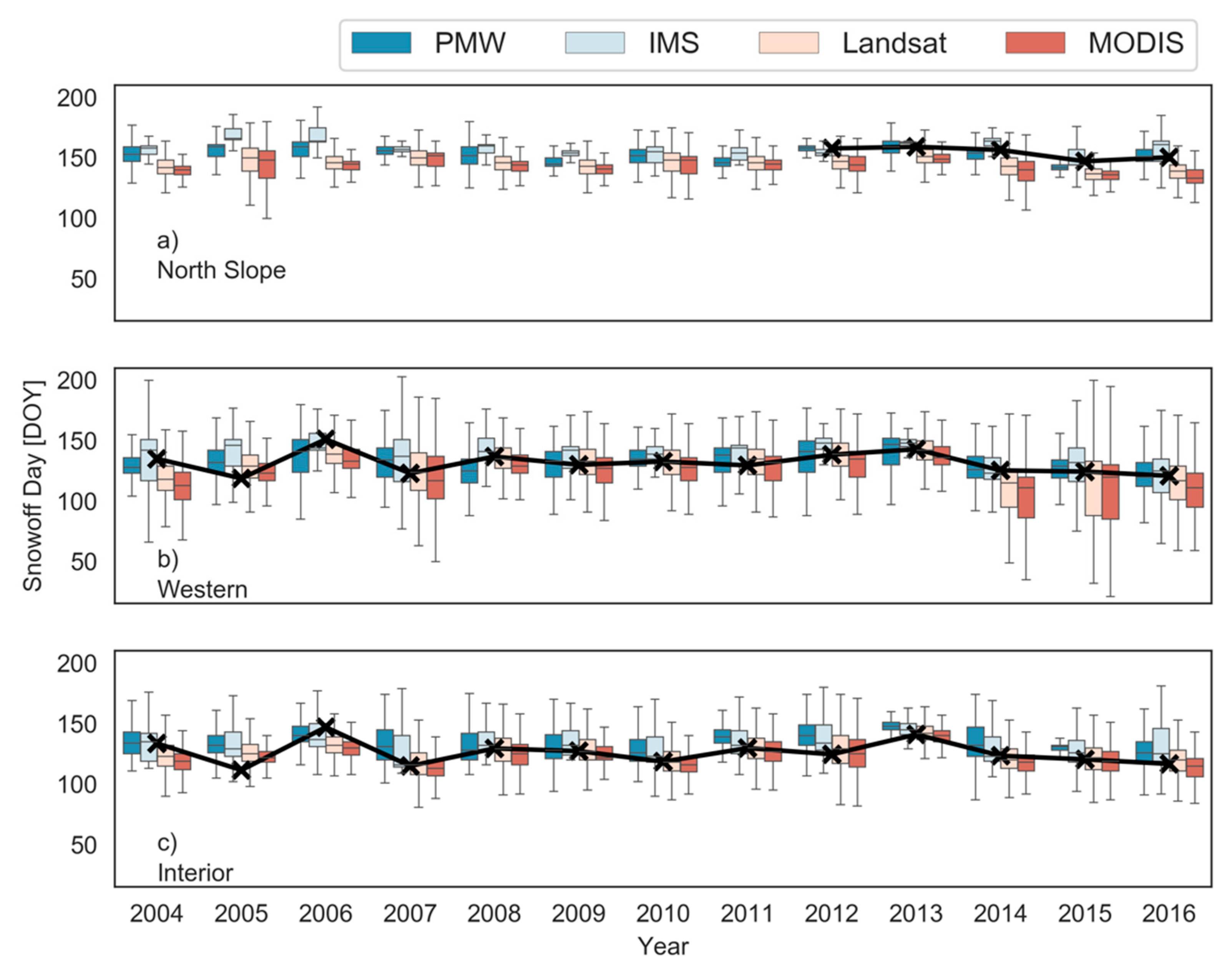
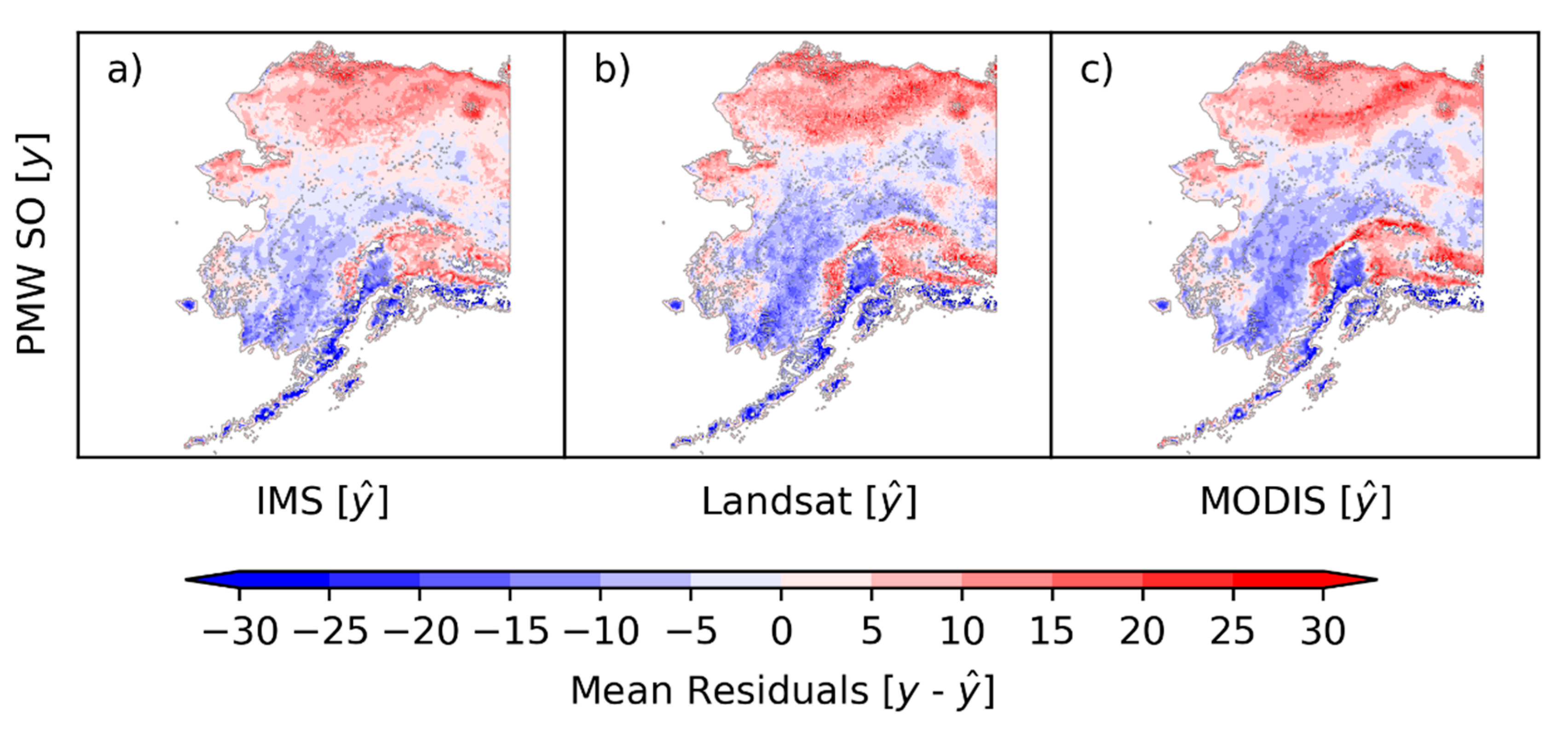
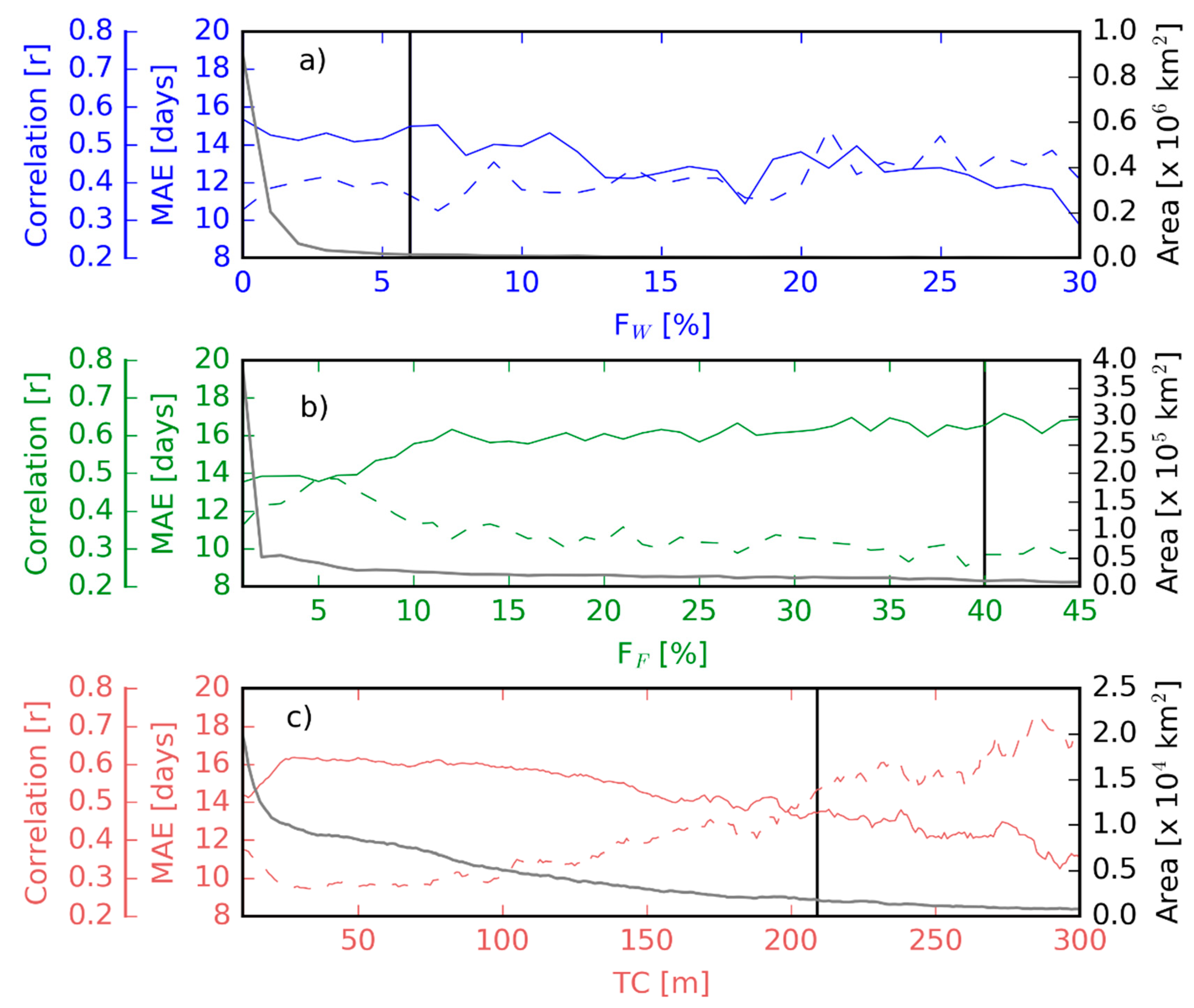
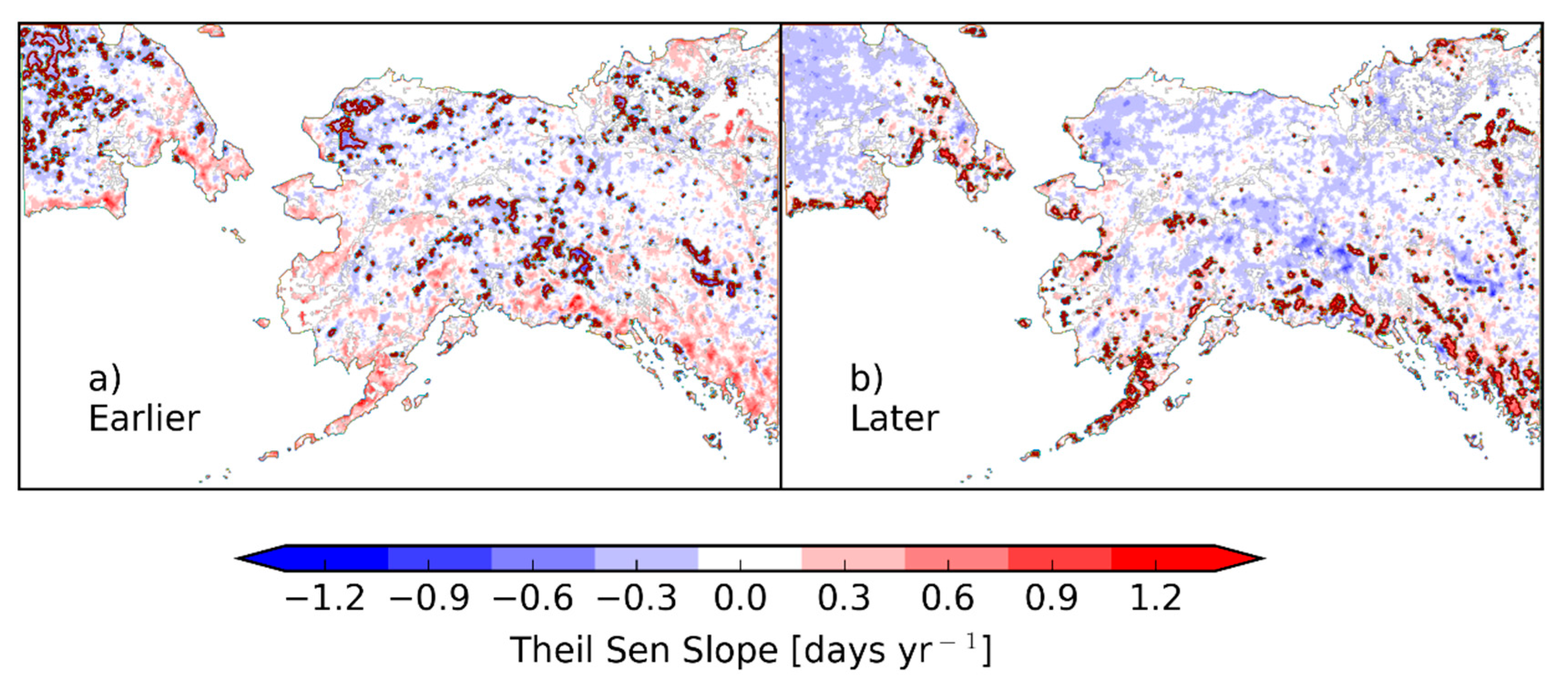
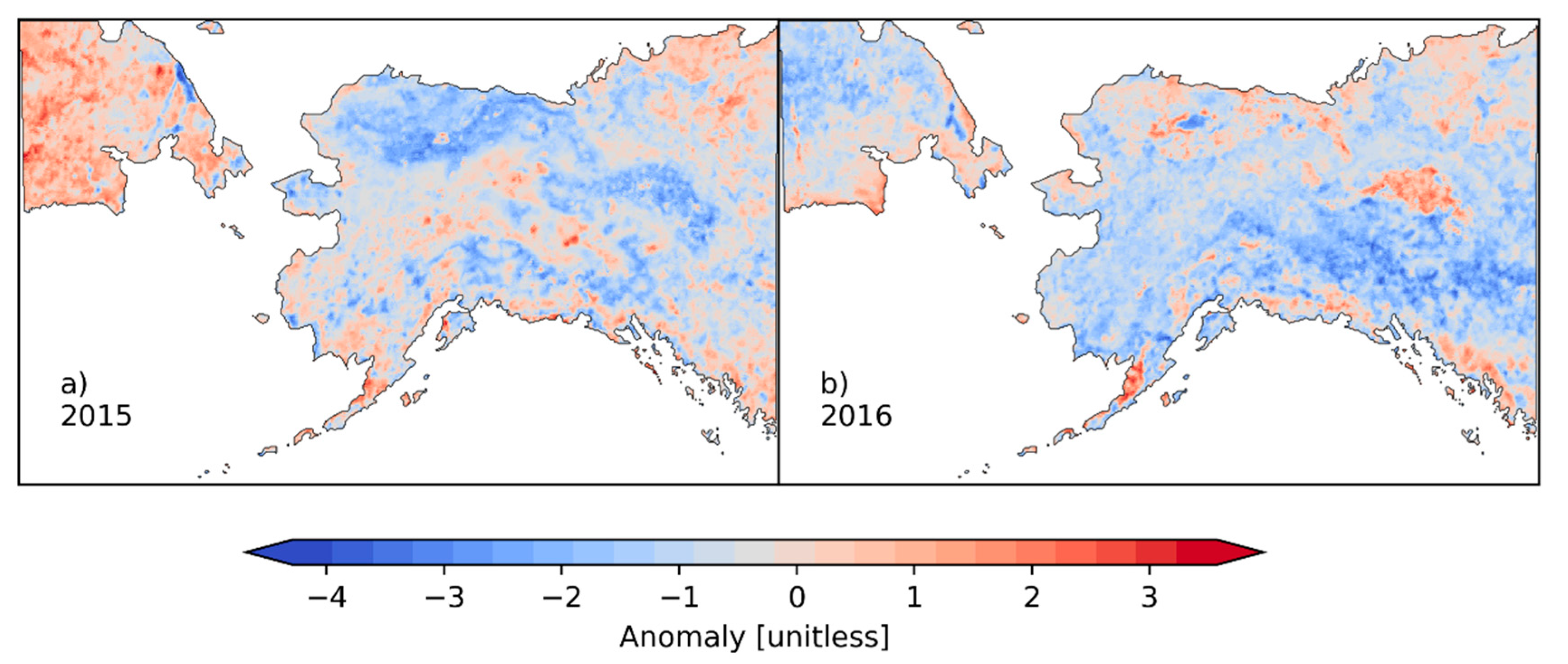
| Dataset | Native Spatial Resolution | Period of Record | Coverage | Source Data Types | Resource |
|---|---|---|---|---|---|
| IMS | 4 km | 2004–2017 | Northern Hemisphere | PMW, Optical, in Situ Observations | Helfrich et al. 2007 |
| Landsat Snow Persistence | 30 m | 2001–2017 | Alaska (southeast excluded) | Landsat | Macander and Swingley 2017 |
| MODIS Snow Metrics | 500 m | 2001–2016 | Russia Far East, Alaska, Northwest Canada | MODIS | Lindsay et al. 2015 |
| PMW | 6.25 km | 1988–2016 | Russia Far East, Alaska, Northwest Canada | PMW | This Study |
| Snowoff Source | Correlation [r] | MAE [days] | RMSE [days] | ||||||
|---|---|---|---|---|---|---|---|---|---|
| Interior | North Slope | Western | Interior | North Slope | Western | Interior | North Slope | Western | |
| PMW | 0.72 | 0.92 * | 0.66 | 10 | 2 | 5 | 11 | 3 | 7 |
| IMS | 0.74 | 0.75 | 0.72 | 10 | 4 | 7 | 11 | 5 | 10 |
| Landsat | 0.73 | 0.93 * | 0.70 | 5 | 11 | 7 | 7 | 11 | 9 |
| MODIS | 0.76 | 0.88 * | 0.71 | 6 | 14 | 12 | 8 | 14 | 14 |
| Residuals [days] | Area [×103 km2] [%] | ||
|---|---|---|---|
| IMS | Landsat | MODIS | |
| <−20 | 23 [2] | 26 [2] | 19 [2] |
| −20–−10 | 70 [6] | 124 [11] | 120 [10] |
| −10–0 | 421 [36] | 420 [36] | 432 [37] |
| 0–10 | 533 [46] | 397 [34] | 418 [36] |
| 10–20 | 119 [10] | 187 [16] | 164 [14] |
| >20 | 3 [0.1] | 16 [1] | 16 [1] |
© 2020 by the authors. Licensee MDPI, Basel, Switzerland. This article is an open access article distributed under the terms and conditions of the Creative Commons Attribution (CC BY) license (http://creativecommons.org/licenses/by/4.0/).
Share and Cite
Pan, C.G.; Kirchner, P.B.; Kimball, J.S.; Du, J. A Long-Term Passive Microwave Snowoff Record for the Alaska Region 1988–2016. Remote Sens. 2020, 12, 153. https://doi.org/10.3390/rs12010153
Pan CG, Kirchner PB, Kimball JS, Du J. A Long-Term Passive Microwave Snowoff Record for the Alaska Region 1988–2016. Remote Sensing. 2020; 12(1):153. https://doi.org/10.3390/rs12010153
Chicago/Turabian StylePan, Caleb G., Peter B. Kirchner, John S. Kimball, and Jinyang Du. 2020. "A Long-Term Passive Microwave Snowoff Record for the Alaska Region 1988–2016" Remote Sensing 12, no. 1: 153. https://doi.org/10.3390/rs12010153
APA StylePan, C. G., Kirchner, P. B., Kimball, J. S., & Du, J. (2020). A Long-Term Passive Microwave Snowoff Record for the Alaska Region 1988–2016. Remote Sensing, 12(1), 153. https://doi.org/10.3390/rs12010153




